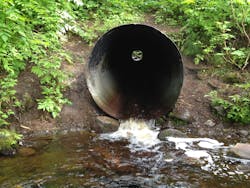Popular Alaskan park repairs 19 aging culverts
Nineteen aging culverts were located underneath the sole public-access road leading to Auke Recreational Area, a popular scenic beach located in Tongass National Forest near Juneau, Alaska. This area is also the site of an Auk Tlingit Native American village and burial ground.
The culverts were approximately 100 yd from the salt-water Auke Bay, which is home to wildlife such as salmon, whales, harbor porpoise, harbor seals and more. The peak season for this popular beach also coincides with the Alaska Department of Transportation’s (AKDOT’s) fish window for addressing problems with the culverts.
The 70-year-old culverts, though still intact, were badly deteriorated, visibly rusting at the invert. One of the old culverts served as a drainage stream through the park into Auke Bay, while the other 18 culverts served as drainage pipes under the roadway leading to the park. The culverts ranged in diameter from 24 to 60 in., with a total of 1,200 linear feet.
Taking into consideration the environmental and historical aspects of the site, the U.S. Department of Agriculture (USDA) Alaskan Forest Service and local tribal interests wanted to rehabilitate the culverts without any digging. In addition, the Forest Service did not want to disrupt public traffic flow to the park.
The solution was to use high-density polyethylene (HDPE) culvert lining Snap-Tite pipe, the least invasive option when considering the environment, public access to the road, and sacred Native American sites.
Channel Construction served as the contractor on this project. John Morris Sr., a tribal inspector and member of the Taku Kwaan Tribe, also attended the installation to ensure that the sacred tribal sites were not disturbed. During installation for each of the culverts, the contractor first inserted one end of the pipe liners into the damaged culvert. Next, the other end was “snapped” on to a new piece of pipe, joining the male and female ends together. The process continued until each culvert was fully lined with the new pipe. Finally, any annular space between the old culverts and new liner was filled in with grout. The contractor did not have to dig up or disturb the road in order to restore any of the damaged pipes.
The culvert serving as a stream measured 60 in. in diameter and 100 ft in length. It was lined with 54-in. pipe. The other culverts were lined with pipe ranging from 24 to 36 in., with lengths averaging around 70 ft.
“We were pleased with how quickly the lining process went, and that sacred sites would not be disturbed through this process,” said Morris.
